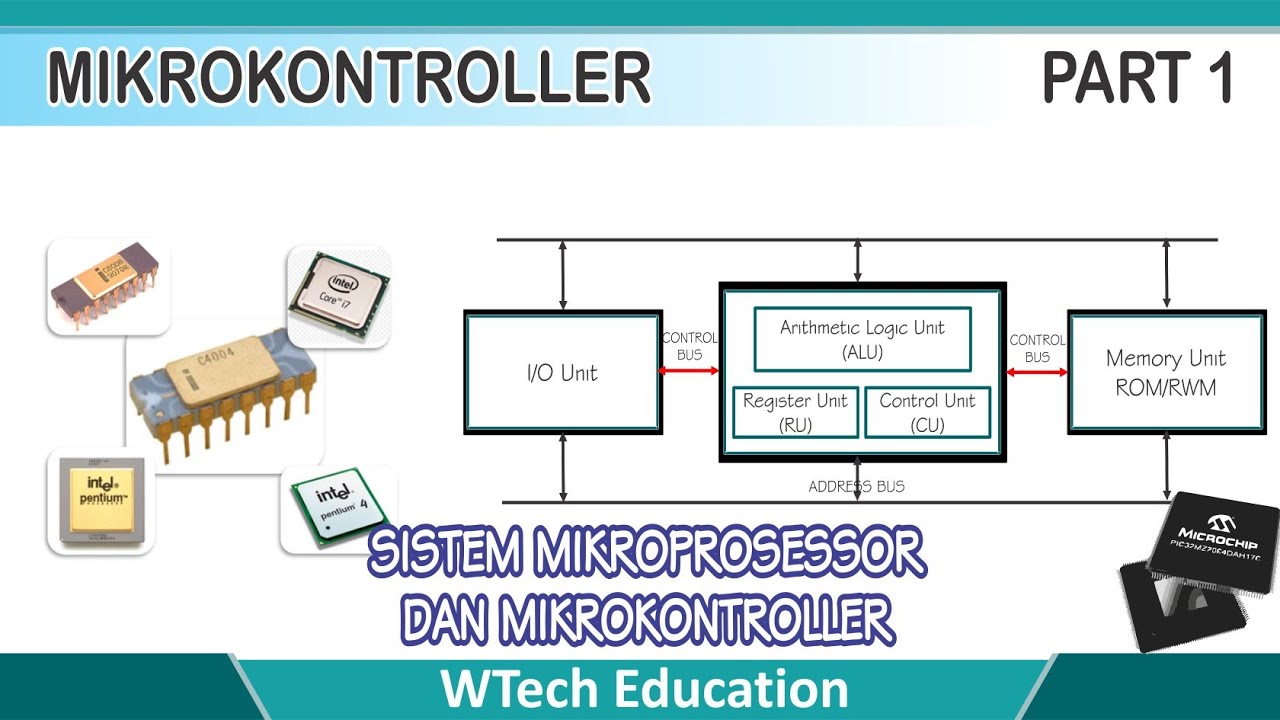Lec-1: Microprocessor and Microcontroller in Computer system
Summary
TLDRThis video explains the concepts of microprocessors and microcontrollers, emphasizing their differences, technical components, and real-world applications. It discusses the evolution of microprocessors from larger CPUs to smaller, more efficient integrated circuits, and the role of word size, clock speed, and multi-core processors in improving performance. The video contrasts microprocessors, used in general-purpose computing like PCs, with microcontrollers, which are designed for specific tasks in embedded systems like washing machines and microwaves. Key terms like memory size, processing speed, and their implications for modern technology are also covered.
Takeaways
- 😀 Microprocessors and CPUs are often used interchangeably, but a microprocessor is the actual implementation of the CPU on a chip.
- 😀 Over time, advancements in VLSI (Very Large Scale Integration) technology have significantly reduced the size of microprocessors, allowing millions of transistors to fit on a single chip.
- 😀 Modern processors often have a 64-bit word size, which increases processing speed and allows for larger memory (e.g., 16GB or 32GB RAM).
- 😀 The clock speed (measured in GHz) determines the processor’s performance, with higher speeds leading to faster data processing and more operations per second.
- 😀 Multi-core processors, such as dual-core or octa-core systems, improve computational efficiency by enabling parallel processing of tasks.
- 😀 A microprocessor is typically used in general-purpose systems like computers, whereas a microcontroller is a specialized chip used in embedded systems (e.g., washing machines, microwaves, automobiles).
- 😀 Microcontrollers integrate not only the CPU but also memory and I/O devices on the same chip, making them ideal for specific, fixed functions.
- 😀 In modern systems, 64-bit processors are common, allowing for better memory management and faster performance compared to older 32-bit systems.
- 😀 The evolution of processor generations has seen advances from early microprocessors like Intel 8080 to more powerful ones like Intel Pentium and Core processors.
- 😀 The memory size in a system is dependent on the word size of the processor, with 64-bit systems supporting significantly larger RAM than older 32-bit systems.
- 😀 Microcontrollers are designed for specific tasks and cannot be modified to perform tasks outside their predefined functions, unlike microprocessors in general-purpose computing.
Q & A
What is the difference between a microprocessor and a CPU?
-A CPU (Central Processing Unit) is a general term for the main processing unit of a computer. A microprocessor is the physical implementation of the CPU in the form of an integrated circuit (IC) chip, which is compact and more efficient.
What are the main components that make up a microprocessor?
-A microprocessor is built using millions of small components, including registers, transistors, and diodes, all integrated onto a single chip.
Why has the size of microprocessors decreased over time?
-The decrease in size is due to advancements in technology like VLSI (Very Large Scale Integration), which allowed more components to be integrated onto a single chip, making microprocessors smaller and more efficient.
What is the significance of word size in a microprocessor?
-Word size refers to the number of bits a processor can handle in a single operation. A larger word size, like 64-bit, allows for faster data processing and larger memory addressing, making the system more powerful.
How does clock speed affect a microprocessor's performance?
-Clock speed, measured in Hertz (Hz), indicates the number of clock cycles a processor completes per second. A higher clock speed means the processor can execute more instructions in a given time, making it faster.
What does multi-core technology mean in microprocessors?
-Multi-core technology means having multiple processing units (cores) in a single microprocessor. This allows parallel processing, where different tasks can be executed simultaneously, improving overall system performance.
How does an Octa-core processor differ from a Quad-core processor?
-An Octa-core processor has eight cores, allowing it to handle more tasks simultaneously compared to a Quad-core processor, which has only four cores. This leads to better performance in multi-tasking and parallel execution.
What is the difference between a microprocessor and a microcontroller?
-A microprocessor is a general-purpose processor used in systems like PCs and laptops for complex tasks, whereas a microcontroller is a small, specialized computer with integrated CPU, memory, and I/O for specific tasks, like controlling appliances.
Why is a microcontroller more suitable for devices like washing machines and microwaves?
-A microcontroller is designed for specific tasks, so it is ideal for applications that require fixed functions, like controlling the operations of a washing machine or microwave. It is a compact system with integrated components for a defined purpose.
How do advancements in technology affect the generations of microprocessors?
-Advancements like VLSI and increasing transistor density have led to the development of more powerful and smaller microprocessors. Modern processors like Intel Core and Octa-core systems are much faster and more capable compared to older generations, which included simpler designs like Intel 8080.
Outlines

Этот раздел доступен только подписчикам платных тарифов. Пожалуйста, перейдите на платный тариф для доступа.
Перейти на платный тарифMindmap

Этот раздел доступен только подписчикам платных тарифов. Пожалуйста, перейдите на платный тариф для доступа.
Перейти на платный тарифKeywords

Этот раздел доступен только подписчикам платных тарифов. Пожалуйста, перейдите на платный тариф для доступа.
Перейти на платный тарифHighlights

Этот раздел доступен только подписчикам платных тарифов. Пожалуйста, перейдите на платный тариф для доступа.
Перейти на платный тарифTranscripts

Этот раздел доступен только подписчикам платных тарифов. Пожалуйста, перейдите на платный тариф для доступа.
Перейти на платный тарифПосмотреть больше похожих видео

Comparison of Microprocessor & Microcontroller | Basics of Microprocessor| Basics of Microcontroller

What is the Difference Between a Microprocessor, Microcontroller and a Microcomputer?

Sistem Mikroprosesor & Mikrokontroler Part 1

Difference between Microprocessor and Microcontroller

Arsitektur Sistem Mikroprosesor

Sistem Mikrokontroler - 01 - Pengantar Mikrokontroler
5.0 / 5 (0 votes)
